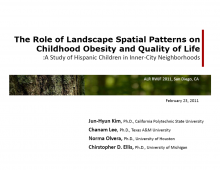We are pleased to announce an exciting new alliance between Active Living Research and GP RED to co-host and coordinate...
The Role of Landscape Spatial Patterns on Childhood Obesity and Quality of Life: A Study of Hispanic Children in Inner-City

Presentation at the 2011 Active Living Research Annual Conference
Background:
Preventing childhood obesity has become a major public health challenge in the U.S. Recent evidence shows that the well-designed built environment that supports walking, bicycling and other physical activities can help reduce childhood obesity and improve other health conditions. While a growing body of empirical studies has investigated the influence of the built environment on physical activity and public health, there is a dearth of research investigating the role of natural environments in childhood obesity and quality of life. Urban natural environments can provide positive effects on public health not only by promoting outdoor activities but also by helping to relieve daily stresses. As a crucial element shaping urban natural environments, landscape spatial patterns can help deal with some of the problems of sedentary lifestyles by encouraging outdoor activities. In addition, landscape patterns can improve quality of life by increasing the sense of place, purifying physical and mental health by reducing stress and promoting relaxation, and creating beautiful places in which to live. As an under-investigated component of urban environment, landscape spatial patterns require more attention to understand their potentially significant roles in promoting children’s physical activity and health.
Objectives:
The primary aim of this research is to examine the associations among landscape spatial patterns of urban environments, health-related quality of life (HRQOL) and body mass index (BMI) among Hispanic children living in inner-city neighborhoods.
Methods:
One hundred 4th and 5th graders and their mothers were recruited from five elementary schools from Houston, TX. Children’s BMI values were calculated from objectively measured height and weight. Children were surveyed about their environmental perceptions, physical activity, and socio-demographic factors. In addition, both the children and their mothers completed the PedsQL survey (Pediatric Quality of Life Inventory) to measure the children’s HRQOL. Using high-resolution Digital Orthophoto Quarter Quadrangle (DOQQ) aerial photo imagery, landscape spatial patterns of urban natural elements were measured by Geographic Information Systems (GIS) and remote sensing. To capture landscape spatial patterns, the DOQQ imagery was classified into 40 classes based on spectral similarity. These 40 classes were grouped into three main land cover types: tree, grass, and developed areas. FRAGSTATS, a spatial pattern analysis program, was used to compute various landscape indices for areas within a half-mile and a quarter-mile distance from each child’s home, using the airline distances.
Multiple regression models were used to predict the children’s BMI and HRQOL. Four groups of independent variables were examined: landscape indices, socio-demographic variables, physical activity, and environmental perceptions and satisfaction (factor variables). Separate models were estimated for the GIS variables captured at different buffer distances.
Results:
In addition to several socio-demographic, physical activity, and environmental perceptions variables, this research showed that several landscape indices were significantly correlated with the children’s BMI and HRQOL. From the half-mile airline buffer assessments, regression models showed that well-connected landscape spatial patterns (p<.05) were associated with lower BMI. In addition, more tree patches (p<.05) or more disaggregated landscape patterns (p<.01) showed negative relationships with children’s BMI. Children’s BMI was lower in areas with more regularly shaped landscape patterns. From the quarter-mile airline buffer assessments, while larger tree areas (p<.10) were associated with lower BMI in bivariate analyses, there was no strong correlation reported in regression models.
For the children’s HRQOL, results revealed that less fragmented landscape spatial conditions (p<.05) and larger areas of urban forests and tree patches (p<.05) showed positive associations with the children’s HRQOL in the half-mile airline buffer assessments. However, no landscape index played a significant role on the children’s HRQOL in the quarter-mile airline buffer assessments. In addition, regression models showed that children’s BMI was negatively correlated with the HRQOL assessed by maternal respondents reflecting their children’s observed behaviors (p<.05).
Conclusions:
Although there have been a few studies examining associations between greenness calculated by aggregated land use data or NDVI (Normalized Difference Vegetation Index) and physical health conditions, to our knowledge no study has attempted to explain those relationships using detailed measures of landscape spatial structure. This study extends knowledge in terms of this correlation.
This type of multi-disciplinary research on landscape structures, while still in its exploratory stage, showed the potential to serve as a viable framework for guiding decision-making in the planning field and to develop more effective environmental assessment strategies in order to understand built environments for research, policy and intervention purposes. This study could lead to developing urban or neighborhood design guidelines with ecological planning considerations, which could in turn help promote physical activity and quality of life.
Support:
This study was supported by the Robert Wood Johnson Foundation (RWJF)’s doctoral dissertation award through the Active Living Research (ALR) program (#65536), and the Nurture by Steelcase Dissertation Grant from Texas A&M University. Data collection of this paper was supported by the Urban Hispanic Perceptions of Environment and Activity among Kids research funded by RWJF’s ALR program (#63755).
Related Tools & Resources
STAY UP TO DATE
RECENTLY ADDED TOOLS & RESOURCES
MOVE! A BLOG ABOUT ACTIVE LIVING
The "Active Living Conference" aims to break down research and practice silos and...







